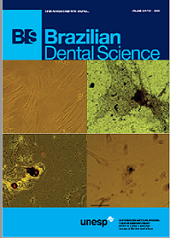Prevalence of temporomandibular disorder and its association with stress and anxiety among university students
DOI:
https://doi.org/10.14295/bds.2020.v23i1.1810Abstract
Objective: The objective was to evaluate the prevalence of Temporomandibular Disorders (TMD) and the association with stress and anxiety among university students. Material and Methods: The Fonseca Anamnestic Index, Trait-State Anxiety Inventory (IDATE) and LIPP Stress Symptom Inventory (LIPP) were applied for 714 voluntaries. Descriptive and inferential statistical analyzes were performed using the chi-square or Fisher's exact test and the Student's t-test or ANOVA, significance level of 5%. Results: The prevalence of TMD was 68.63%, 46.9% had mild TMD. There was a statistically significant difference between the means of age and the severity of the TMD, higher mean values for severe TMD (22.5 ± 3.3 years). There was a statistically significant association between the female and TMD, higher prevalence of mild TMD. Among the volunteers diagnosed with TMD, a significant number were diagnosed without stress, but there was a statistically significant association between those diagnosed with stress and mild TMD, anxiety and TMD, (state: moderate anxiety and DTM - 50%; trait: moderate and severe anxiety and mild DTM - 49.3% and 49.87%, respectively). Conclusion: There was a high prevalence of TMD signs and symptoms, with higher prevalence in the female gender, mild TMD was more significant, and anxiety and stress were significantly present among university students with TMD signs and symptoms.
Keywords
Temporomandibular disorder; Anxiety; Psychological stress.
Downloads
Downloads
Additional Files
Published
How to Cite
Issue
Section
License
Brazilian Dental Science uses the Creative Commons (CC-BY 4.0) license, thus preserving the integrity of articles in an open access environment. The journal allows the author to retain publishing rights without restrictions.
=================




























